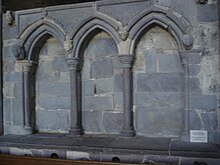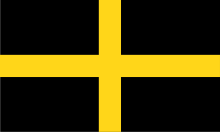Saint David
Saint David | |
|---|---|
St David's Cathedral have been carbon-dated to the 12th century. |
David (
David was a native of Wales, and tradition has preserved a relatively large amount of detail about his life. His birth date, however, is uncertain: suggestions range from 462 to 512.[1] He is traditionally believed to be the son of Non and the grandson of Ceredig ap Cunedda, king of Ceredigion.[2] The Welsh annals placed his death 569 years after the birth of Christ,[3] but Phillimore's dating revised this to 601.[4]
Hagiography

Many of the traditional tales about David are found in the Buchedd Dewi ("Life of David"), a hagiography written by Rhygyfarch in the late 11th century. Rhygyfarch claimed it was based on documents found in the cathedral archives. Modern historians are sceptical of some of its claims: one of Rhygyfarch's aims was to establish some independence for the Welsh church, which had refused the Roman rite until the 8th century and now sought a metropolitan status equal to that of Canterbury (this may apply to the supposed pilgrimage to Jerusalem where he is said to have been anointed as an archbishop by the patriarch).
The tradition that he was born at
His best-known
The
Fluellen: "If your Majesty is remembered of it, the Welshmen did good service in a garden where leeks did grow, wearing leeks in their Monmouth caps, which your Majesty knows, to this hour is an honourable badge of the service, and I do believe, your Majesty takes no scorn to wear the leek upon Saint Tavy's day". King Henry: "I wear it for a memorable honour; for I am Welsh, you know, good countryman".
Connections to Glastonbury
Death

Though the exact date of his death is not certain, tradition holds that it was on 1 March, which is the date now marked as Saint David's Day.[10] The two most common years given for his death are 601 and 589. The monastery is said to have been "filled with angels as Christ received his soul". His last words to his followers were in a sermon on the previous Sunday. The Welsh Life of St David gives these as, "Arglwyddi, brodyr, a chwiorydd, Byddwch lawen a chadwch eich ffyd a'ch credd, a gwnewch y petheu bychain a glywsoch ac y welsoch gennyf i. A mwynhau a gerdaf y fford yd aeth an tadeu idi",[11] which translates as, "Lords, brothers and sisters, Be joyful, and keep your faith and your creed, and do the little things that you have seen me do and heard about. And as for me, I will walk the path that our fathers have trod before us." "Do ye the little things in life" ("Gwnewch y pethau bychain mewn bywyd") is today a very well known phrase in Welsh. The same passage states that he died on a Tuesday, from which attempts have been made to calculate the year of his death.
David was buried at
Veneration

David was officially recognised at the
Over 50 churches in South Wales were dedicated to him in pre-Reformation days.[5]
In the 2004 edition of the Roman Martyrology, David is listed under 1 March with the Latin name Dávus. He is recognised as bishop of Menevia in Wales who governed his monastery following the example of the Eastern Fathers. Through his leadership, many monks went forth to evangelise Wales, Ireland, Cornwall and Armorica (Brittany and surrounding provinces).[12]
The restored Shrine of Saint David was unveiled and rededicated by the
A broadside ballad published around 1630 claimed that the Welsh wore a leek in their hats to commemorate a battle fought on St David's Day. So as to recognise friend from foe, the Welsh had pulled up leeks from a garden and put them in their hats, before going on to win the battle.[13]
Saint David is usually represented standing on a hill with a dove on his shoulder.[1]
David is
Reputation
David's popularity in Wales is shown by the Armes Prydein of around 930, a popular poem which prophesied that in the future, when all might seem lost, the Cymry (Welsh people) would unite behind the standard of David to defeat the English; "A lluman glân Dewi a ddyrchafant" ("And they will raise the pure banner of Dewi").
David is said to have played a role in spreading Christianity on the continent, inspiring numerous place names in Brittany including Saint-Divy, Saint-Yvi and Landivy.
David's life and teachings have inspired a choral work by Welsh composer Karl Jenkins, Dewi Sant. It is a seven-movement work best known for the classical crossover series Adiemus, which intersperses movements reflecting the themes of David's last sermon with those drawing from three Psalms. An oratorio by another Welsh composer Arwel Hughes, also entitled Dewi Sant, was composed in 1950.
Saint David is also thought to be associated with
See also
- Saint David's Day & Proposed St David's Day bank holiday
- Saint David's Cathedral
- Saint David's Castle & St David's Church, Naas
- Saint Divy Parish close, Brittany
- Saint David, patron saint archive
- Proposed origins of the tale of Davy Jones' Locker
References
Citations
- ^ a b c Toke, Leslie (1908). . In Herbermann, Charles (ed.). Catholic Encyclopedia. New York: Robert Appleton Company.
- ^ "The early life of David". BBC. Archived from the original on 10 January 2008.
- ^ B text. Public Record Office, MS. E.164/1, p. 8. (in Latin)
- ^ Phillimore, Egerton (ed.), 1888 "The Annales Cambriae and Old Welsh Genealogies from Harleian MS. 3859", Y Cymmrodor; 9 (1888) pp. 141–183.
- ^ a b c "Saint David of Wales". Franciscan Media. 1 March 2016. Retrieved 25 September 2020.
- ^ Davies, John (2007) [1993]. A History of Wales. London: Penguin. p. 74.
- ^ Wade-Evans 1923, pp. 107-, §48, §53.
- ISBN 0-9754844-0-0"David and his fellow members within this community believed hard manual labor was the duty of all, thus preferring not to use cattle to help them plow the fields. They resolved to maintain a diet of bread and vegetables, with just a sprinkling of salt, so as not to inflict unnecessary suffering upon any creature by taking its life for food."
- ^ Wade-Evans 1923, pp. 80-, §13.
- ISBN 9781843833222.
- ISBN 978-0-7083-0995-7.
- ^ Martyrologium Romanum, 2004, Vatican Press (Typis Vaticanis), page 171.
- ^ The Praise of Saint Davids day. / Shewing the Reason why the Welshmen honour the Leeke on that day. To the tune of When this Old Cap was new. (?1630).
- ^ "The Calendar". The Church of England. Retrieved 27 March 2021.
- ISBN 978-1-64065-234-7.
- ISBN 9780854099382.)
{{cite book}}: CS1 maint: location missing publisher (link
Sources
- Vitae Sanctorum Britanniae et Genealogiae (Latin), ed. Arthur W. Wade-Evans. Cardiff: University of Wales Press, 1944.
- Lewis, Lionel Smithett (2003). "St. David the Briton". St. Joseph of Arimathea at Glastonbury Or the Apostolic Church of Britain 1955. Kessinger Publishing. ISBN 978-0-7661-4013-4.
- ISBN 978-7-270-00726-7.
- St. David's Day section of Observations on popular antiquities, chiefly illustrating the origin of our vulgar customs, ceremonies and superstitions : Arranged and rev., with additions, Volume 1 (ASCII text) by John Brand
- Wade-Evans, Arthur Wade, ed. (1923). Life of St. David. Society for Promoting Christian Knowledge.
Further reading
- Morgan, Gerald, In Pursuit of Saint David. Y Lola Cyf., 2017. ISBN 978 1 78461 3723
